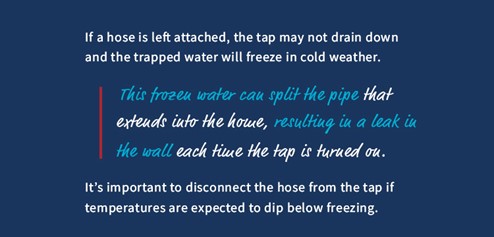
The leaves will begin turning from green to orange, and you have thought about pulling out and dusted off your favorite warm sweaters. Fall is in the air and as any homeowner knows, it is the perfect time to complete some important home maintenance.
- Check Caulking and Weather Stripping
First up on our fall home maintenance checklist is a thorough check of the caulking sealing your home’s windows and doors to ensure the caulking and weather stripping is in good repair.
Notice a gap or some loose caulking?
Now is a great time to bring out the caulking gun and make those necessary corrections.
- Drain Exterior Water Lines
Ensuring the hose connected to the outside of your home is disconnected in the fall is a crucial step in ensuring your home stays in good repair. Also check our additional guide to bleeding your exterior hose bib.

- Check Carbon Monoxide and Smoke Detectors
A safe home is a content home. A quick test of your CO2 and smoke detectors will give you peace of mind and allow you to ensure they are working properly. Check your batteries during your check and change when necessary.
- Clean Range Hood and Over the Range Microwave Filters
Grease and fats build up in the filter as you cook, and it is important to clean or change them monthly.
- Check for Soil Settlement at Foundation
As we head into the winter months, ensuring that the grade slope around your foundation, and home are positive is incredibly important.
Check to make sure that no soil has settled near the foundation of your home, and if it has, correct it right away by topping the soil up, re-creating the positive grade.
- Inspect Downspouts
To ensure proper water surface management please ensure that your downspouts are attached and are in the down position, this is so particularly important so that you have the proper surface water management.
- Inspect Floor Drains
A home’s floor drains are typically located next to the furnace and work to help remove water spilled on the basement floor.
To prevent sewer gas from entering your home through floor drains, it is essential to make sure there is always water present in the drains.
For a simple test to determine whether your drains have water in them, pour a small amount of water into the drain and listen. If you hear the water hit more water, you are in good shape. If the water you pour into the drain sounds like it is hitting the bottom of the trap, your system could use a top up.
Every few months or if you smell sewer gas, pour a bucket of water down the drain to re-establish the water seal.
- Check Furnace and Ventilation System Filters
To keep your ventilation systems operating efficiently, clean or replace filters as necessary and keep outdoor intake vents clear of obstructions.
A dirty or plugged furnace filter can limit air flow from the furnace to the ducts; this makes your furnace work harder, and your power cost more.
Inspect and clean or replace the furnace air filter at the beginning of the heating season and on a regular basis throughout the winter months to ensure your HVAC system is running at its best performance.

